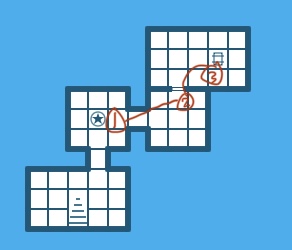It can sometimes be weird or unintuitive how time passes in the dungeon so let’s break it down in simple terms, as a complement to the terse DM reference version.
An exploration turn (in our group, we’ve started calling them “ticks” to make it even more clear we’re not talking about combat rounds) are about ten minutes, on average. Sometimes a li’l more, sometimes a li’l less, but that’s what they represent.
Let’s start with an example.

They mess around with the statue, that’s one tick.
Then they listen at the door, examine the door, and then pick the lock
on that door. That’s all in the second tick.
Then they find a chest and fiddle with it and bork it up and maybe
they trigger a needle trap and have to cast a Lesser Restoration
spell. That’s the third tick.
That’s thirty minutes. Maybe it’s not literally ten + ten + ten, some might be a li’l more and some a li’l less, but at the granularity we’re working at, it’s thirty for the whole lot.
Some versions of D&D have a “per combat round” speed, others have a “per exploration turn” speed; to convert, multiply by three. So a speed of 30’ in the “rounds” games will show up as 90’ in “ticks” games.
So in “ticks” games, the idea is that when you need a “rounds” speed, you divide by three, so you’ll have a “combat speed” separate from an “exploration speed”.
In our house system, we have the combat speed listed on character sheets (and affected by encumbrance etc) and I usually use an exploration speed that is fixed at sixty, because as you’ll see below, it almost never matters.
Just looking at things, tossing and turning, lifting things, tapping on things, pulling levers and pushing buttons, you can do any amount of those… as long as it’s within the same 10’ by 10’ by 10’ cube. (As per Moldvay, p B19). One tick is enough for you to go through every drawer in a chest, for example.
You don’t have to worry about movement, just counting interactions, as long as you can draw a 60’ by 60’ “exploration area” that contains both this new “interaction cube” and the previous one. And that’s almost always the case, especially if you’re like me, really stingy about what counts as “interaction” (like picking up a coin from the floor).
Every new “exploration area” they have to enter, that’s a new tick, but their interactions are usually densely spaced enough for that to not happen, as you can see in the example up top. Statue, door, chest, that’s three ticks. The chest is more than sixty feet from the statue, but they stopped at the door in between and only the two most recent stops at any given time need to fit in the same “exploration area”.
This is why I say that exploration speed almost never matters. If you wanna get super technical about it, instead of 60, use the listed exploration speed (in “ticks” games), or three times the combat speed (in “rounds” games).
If you are carefully mapping out, you can cover an entire “exploration area” within one tick. That is in addition to searching, but again, movement is included.
Here’s where speed really matters and those clunky armors have their cost. For exploration speed 60’, that’s 36 ten foot squares or 144 five foot squares. For exploration speed 90’, it’s 81 ten foot squares or 324 five foot squares.
So using the same statue-door-chest example as above, they can map all the 35 squares outside the locked door in one tick even at 60’.
Movement within in known-and-clear space is way faster. It’s more like a 2000’ by 2000’ area, like a third of a mile. But, just like before, any interaction on the way is a tick. So if they’re like “We go to the fountain room” but there are some skeletons in the hallway on the way there, that’ll slow them down.
This is only for places they’ve already been. The first time through, use the smaller exploration areas. So if they move 300 feet without interacting anything, that’s still 5 ticks, but then they can go back through there without a problem. Whether restocked areas count as “known-and-clear” is up to the characters’ perception. If they don’t know that ghosts have moved in, they wouldn’t suddenly slow down. My take is that it’s primarily about finding their bearings in the architecture of the place.
Sometimes they just wanna do more time intensive things, or things that already have a listed amount of time in the rules, like resting (different depending on editions) or casting ritual spells. (5e has a lot of 11 minute spells… My ruling is that an 11 minute spell does fit within one tick.)
Keeping track of the real-world time is good but be careful so you don’t double-charge. Let’s say the players talk for 27 minutes and their characters take a 60 minute rest. Obviously that’s not 87 minutes diegetically, it’s just 60, so just charge them six ticks.
The idea that their talking makes the time pass in the dungeon is great, we’ve been doing that for years, but always taking care to not “double charge”. If their characters take actions worth three ticks and they talk for 40 minutes? That’s four ticks, not seven. If they speak loudly, modify the encounter checks (maybe give them disadvantage).
This goes for other parallel action, too. Four people can search a 40’ by 10’ area (or a 20’ by 20’ area) in a single tick, just be mindful that their torch is where it covers them all.